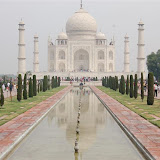standing in a airport store; i am watching those around me to make their purchases, last minute items with the local city name emblazoned on them. trinkets taken as memories or nearly forgotten gifts for others. it's not uncommon for me to be doing more than one thing at once. cafes, stores and queues are such natural places for me to consider life and profile the lives of others. both are done in the background, happening as the foreground moves past seemingly by itself.
holding a postcard (to be used as framed art) and and a hat i will probably never wear, i look down and see a book that grabs my attention. "traffic: why we drive the way we do (and what it says about us)" by tom vanderbilt. i shift my overweight messenger bag on my shoulder and consider the cost of schlepping one more paperback halfway around the world.
i began this trip with nearly empty bags, i am leaving with them stretched to the limit. a starbucks mug purchased as a "personal cup" for my daily caffeine break was left behind to ensure the tension of the zipper did not exceed safety specs. i am down to carrying items on my back that should have been stowed as checked baggage. but i am standing with a growing list of last minute purchases, and this last one promises to explain why we are the way we are. there was really no choice in the matter, the weight of a paperback never out weighs the promise of enlightenment.
first admission first, i regularly switches from left hand drive to right, i have been known to drive at double the posted speed limit and i have taken to reading gender and ethnicity in my temporary homeland by viewing the car and driving style from a distance. i was also carrying three new books on lie detection through microexpressions, a subject i learned about by watching psychological-CSI series "lie to me". i have also written a previous post on auto profiling. i take all of this to mean that i am trying to better understand people; including myself. here is a book that will show me how to read people even better at 73 miles per hour.
the scope and breath of this book is amazing. there are discussions of driving in the US, amsterdam, australia, china, india and random other places over the world. the fact that i have experienced the traffic in so many of these places first-hand made the conversation all the more interesting. a point well made in the book is that driving styles are cultural and are based on the rules and order of the larger society. driving may be a universal skill, but it is also a newly learned one which take cues from the drivers social environment.
there are an amazing number of things to take away from this book, many are completely counter-intuitive. an example is that a bicyclist who uses hand signals is more likely to be hit by a car, which goes against all road safety lessons i have learned and taught. the reasons, proven by studies referenced in the book, is because the drivers would actually see the cyclist as a person and begin to seek eye contact. this both slows their reflexes and brings them closer to the cyclist. this desire for eye contact is touched on throughout the book, and comes with a revelation that humans have evolved to travel at no more than 20 miles per hour, above which we lose our ability to track items and make effective use of social cues to ensure safety.
over 20 miles per hour we also begin to sample the world rather than reading it fully, this filtering process allows us to lower the amount of information we take in from the stream of input passing by our windows. as we go faster we selectively disregard elements of the environment, including road signs, pedestrians and other cues which do not trigger the risk warning systems tuned by evolution to warn us of approaching dangers.
the major point i walked away from the book with was that driving is boring, which most humans have a low tolerance for and to compensate we do two things. the first is to zone out during the act of driving, going into a semi-trance where we may simply not remember how we got from one place to another. these blank spots appear to be tied to driving while tired, suggesting that we are not zoned out as much as moving rapidly while napping behind the wheel of a very dangerous object with both mass and velocity. this is a scary suggestion for one who does as much tired driving as i do; and yes i do have moments of "how did i get here".
to counter the boredom we find ways to add driving tension, by making it more challenging. someone might choose to do this by increasing the speed, closing distances between ourselves and other vehicles, adding handphone conversations, email or IM exchanges or scanning for music on your ipod. for some of us in the lower extremes of boredom tolerance, or is that the upper extremes of fast-task-switching, we may elect to do multiple of these at once.
i was absently considering this as i drove home this week. i was listening to blues on the ipod, having a conversation with someone in the office and cruising down a street i manage with little conscience attention. that is when the motorcycle cop magically appeared at my side window, then slowed to point at my headlights. i have been waved at multiple times for my "always on" head lights, but it looked like this time i was getting pulled over. after stopping i found that the issue was not the headlights, but that driving while on a handphone really is illegal in malaysia. i then discovered that i should have gotten a local license 3 years ago, although i know of no expat who has ever done this. it has never come up when negotiating prior speed traps.
the indian officer and i had a nice chat. i showed him the book on traffic from my bag, told he that he was right to give me a ticket because it was a distraction. i controlled myself from explaining that i might actually be safer with the phone conversation because otherwise i would be without the tension required for me pay any attention to the road. i heard myself think, "you know officer, i could be asleep at the wheel, but speeding and using the phone keep my ADD at bay and allow me to be safer". my recently acquired filters kicked in, finally i may have learned that less really is more.
in the end, the officer asked me if i "wanted to compromise". shockingly this didn't mean i could pay the fine (tip) immediately, just that i should use the hands-free i had in my bag, if i needed to talk and drive at the same time. i was let go with a handshake and a smile. i drove away hoping to bump into my new friend in a cafe soon, i would like to have a longer conservation about traffic over a beer.
the way we negotiate driving is cultural, it may be related to language in the way we perceive the flow of information and expect things to follow rules so we can only half listen. adding tension might be the same way some play with words to add irony or dual meanings. needing to modify the level of complexity might help you deal better with the chaos and pace of the world around us.
but sometimes adding the tension can also help you to make new friends; unless you drive into a bridge abutment.











No comments:
Post a Comment